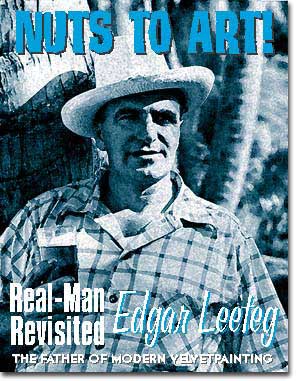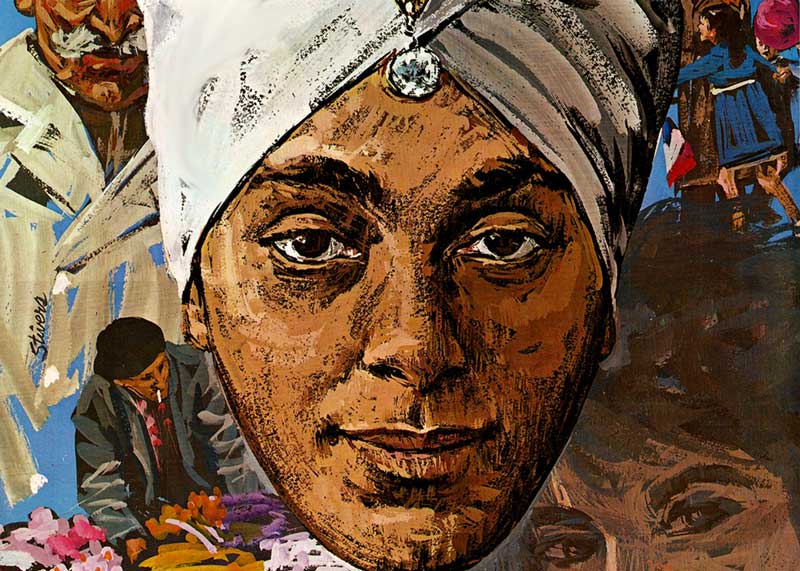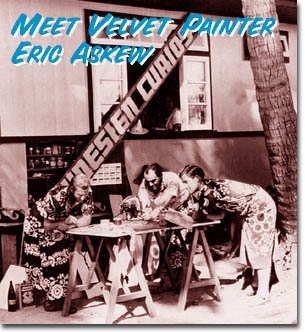
Velvet Painter Eric Askew
In the early 1930s, New Zealand-born artist Eric Askew found himself unable to get work as a commercial artist because of the depression. So, he took up sign painting and pictorial art painting in New Zealand. Around this time, he began surfing and became a member of the Piha Surf Life Saving Club.
Askew aspired to compete in Olympic weight lifting, but had very little money to sustain himself through a long training session. He considered relocating to a place where it was cheaper to live. He figured that Tahiti was a good combination of salubrious climate and affordable living. He planned to move there with a fellow weight lifter Alex Dick, who also happened to be a sign painter.
In a sign painting trade magazine, Askew had seen an article about the velvet painter, Edgar Leeteg. The article showed some of his velvet paintings and said that he lived in Tahiti, so Askew and Dick decided to look up Leeteg once they landed in the islands.
They hit it off with Leeteg, and Leeteg invited the two fellows to live on a piece of land he had on Moorea. Askew and Dick built a hut on the land with a commanding view of Cook’s Bay. They tended a garden for food and learned to cook on hot stones. Between their garden, the coconuts growing nearby and a generally low cost of living, they spent only about $4 a week on food.
They would regularly go to Papeete and visit with Leeteg. Leeteg was usually very secretive about his velvets and would stop painting and cover up his work whenever visitors came by. But as he got to know Askew and Dick better, he became more comfortable, and would work while they watched.

Eric Askew (left) with the famous velvet painter Edgar Leeteg (middle) and Askew’s friend Dick in Tahiti.
Because of the friendship they had developed, Leeteg explained his technique for painting on velvet to Askew, but asked him never to reveal it to anyone.
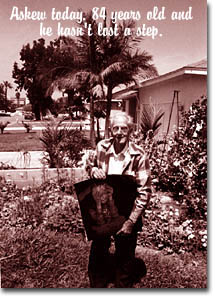 Askew is now 84 years old, but shows no signs of slowing down. He hasn’t surfed in over 30 years, because he says the surf is too crowded, but he still windsurfs and skis regularly. When ski season comes around, he sounds like a teenage ski bum, paring back his work schedule to allow more time for skiing.
Askew is now 84 years old, but shows no signs of slowing down. He hasn’t surfed in over 30 years, because he says the surf is too crowded, but he still windsurfs and skis regularly. When ski season comes around, he sounds like a teenage ski bum, paring back his work schedule to allow more time for skiing.
“It always surprises people that this old fart is out there windsurfing or skiing,” says Askew, “People always ask how old I am and then say, ‘I hope I can do that when I’m you’re age.’ I tell them they can if they want to.
“I tell them they can’t eat at McDonalds. You’ve got to eat a whole lot of fresh fruit and fresh vegetables. Eat whole grains. You can’t have a lot of white sugar. You can’t drink. You gotta cut back on the salt. People say, ‘I can’t do that!’ Then you’ll have a lot of pain when you’re older. There’s no trick way, unfortunately.”
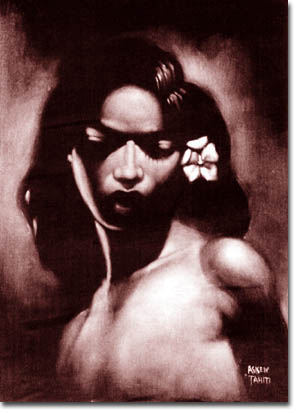 The subjects of Askew’s paintings (which are often bucolic Polynesian portraits and maritime scenes) reflect his love of the sea. “What you paint reflects what is in your mind,” says Askew, “[Crude art] doesn’t appeal to me at all. Why? It appeals to the cruder part of my mind. I don’t want to be involved with that. I don’t want to be around crudity. I want to be around the better things in life.
The subjects of Askew’s paintings (which are often bucolic Polynesian portraits and maritime scenes) reflect his love of the sea. “What you paint reflects what is in your mind,” says Askew, “[Crude art] doesn’t appeal to me at all. Why? It appeals to the cruder part of my mind. I don’t want to be involved with that. I don’t want to be around crudity. I want to be around the better things in life.
“If I paint a nude, it’s got to be a gracious nude, not something crude. It’s a part of me and I’m not going to do something like that.”
Askew, who is still a prolific artist, has started painting velvets again recently, after not having done one for about 25 years.
To this day, Askew honors his 60 year-old promise to Leeteg and has never disclosed the velvet painting secrets Leeteg showed him. Will he ever pass the velvet painting techniques on to a new generation of artists? “No,” Askew answers firmly and abruptly, “Leeteg’s gone on and that’s the way it is. There are a few little tricks there and I might as well hold onto those.”
Eric Askew’s art is featured at the Copro Nason Gallery in Culver City.

